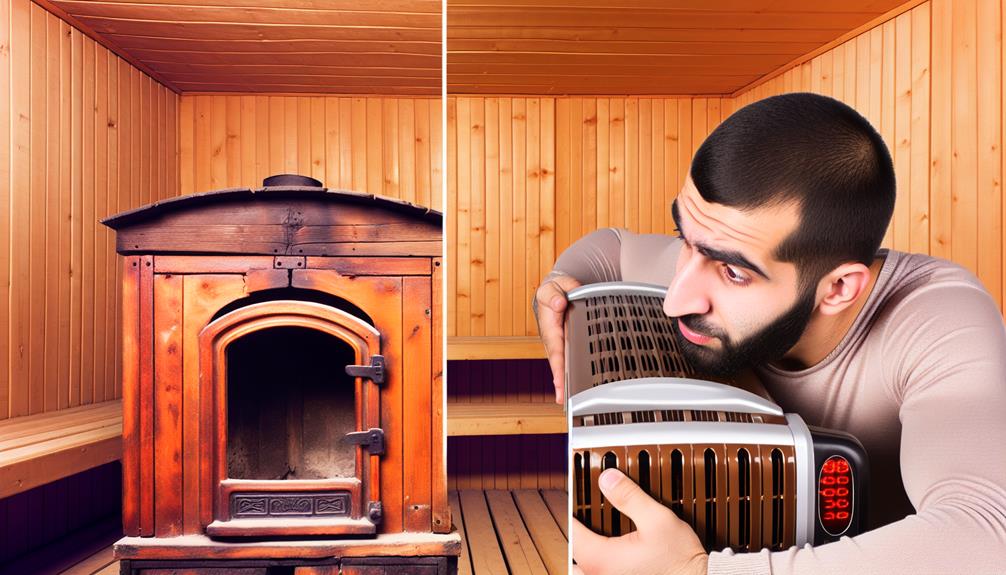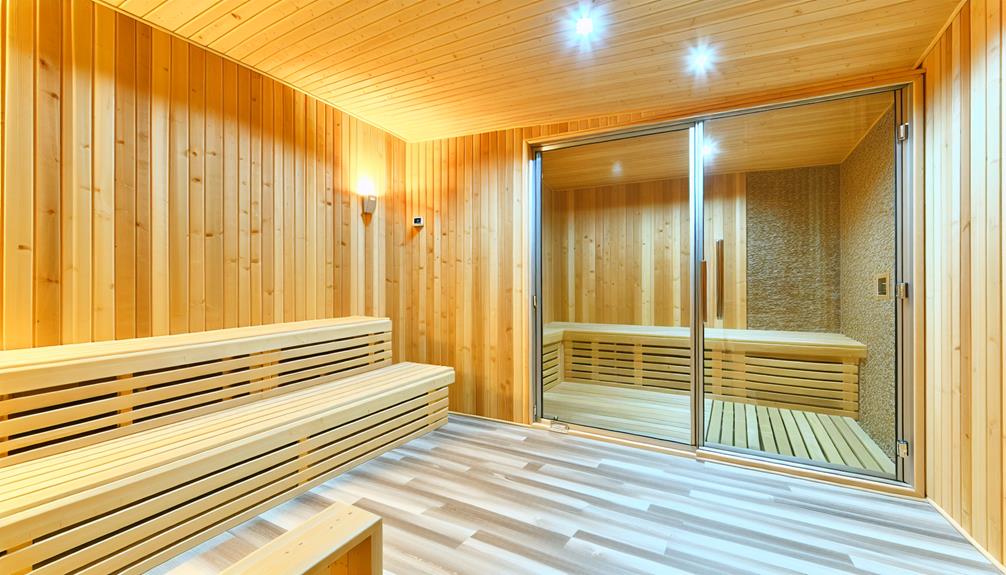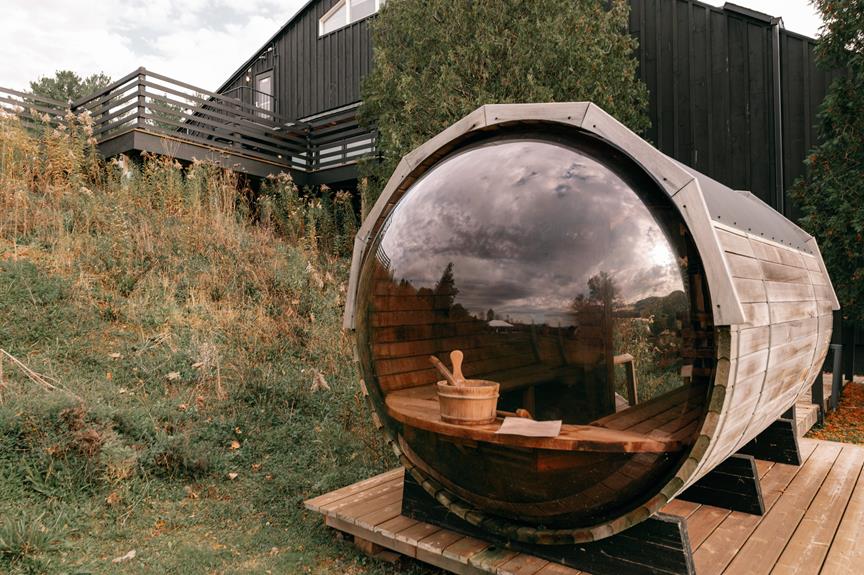When embarking on the journey of constructing your sauna, think of it as laying the foundation for your personal oasis of relaxation.
From choosing the ideal heat source to crafting a serene interior space, each step contributes to creating a haven of tranquility in your home.
But before you can revel in the soothing warmth and rejuvenating steam, there are essential considerations and meticulous planning that are crucial to ensuring the success and functionality of your sauna.
Key Takeaways
- Choose appropriate building materials like cedar or hemlock for moisture resistance.
- Select the right heat source based on size and preference, such as electric or wood-burning heaters.
- Opt for Nordic whitewoods or cedar for a traditional or aromatic sauna experience.
- Incorporate tempered glass windows and wood accessories for a visually appealing and functional sauna design.
Location Selection
When selecting the location for your sauna, consider the existing space and foundation requirements to ensure a safe and stable setup. For indoor saunas, utilizing existing spaces like converted closets or small bathrooms can be convenient and cost-effective. Ensure the area has a solid surface and proper ventilation to handle the heat generated by the sauna.
On the other hand, outdoor saunas may require a level foundation with proper drainage to prevent water damage and maintain stability. These saunas can be built on various flat surfaces such as decks or as separate structures in the backyard based on your preferences. It's crucial to have wiring for electricity in outdoor saunas to power heaters and lighting systems effectively. Hiring a licensed electrician is recommended to handle the wiring, ensuring compliance with electrical codes and regulations for a secure sauna setup.
Proper planning and adherence to these guidelines will contribute to a successful sauna construction project.
Building Materials Needed
Considering the ideal materials for constructing your sauna, the focus lies on selecting cedar, poplar, or hemlock wood due to their excellent moisture resistance and durability. To ensure a well-built sauna environment, here are the essential building materials you'll need:
- Wood: Choose cedar, poplar, or hemlock for their moisture resistance and durability.
- Fiberglass Insulation: Use fiberglass batt insulation with appropriate R-values to maintain thermal efficiency.
- Vapor Barrier: Install foil-faced vapor barriers to prevent moisture penetration and protect the sauna structure.
- Tempered Glass: Opt for tempered glass for doors and fixtures to guarantee safety and durability in the high heat environment.
Additionally, when selecting electrical components for your sauna, make sure to choose humidity-rated items that can withstand the high heat and humidity levels. By using these recommended building materials, you can create a sauna that isn't only durable but also comfortable and safe for your enjoyment.
Heat Source Choice

For optimal heat distribution and efficiency in your sauna, selecting the right heat source is crucial. When deciding on a heat source for your sauna build, consider the various options available to find what best suits your needs.
Electric heaters are a practical choice, offering affordability and low maintenance requirements, making them a popular option among sauna enthusiasts.
If you prefer a more traditional sauna experience with the aroma of burning wood, wood-burning heaters might be the perfect fit, although they do require more upkeep.
Infrared heaters provide a unique sauna experience by using light to generate heat, offering a different sensation compared to traditional heat sources.
Gas heaters are known for their quick heating capabilities and efficient operation, making them another viable choice for your sauna project.
When making your decision, take into account the size of your sauna, desired heat output, and personal preferences to enhance your overall sauna experience.
Interior Finishes Selection
To create a captivating and authentic sauna ambiance, carefully selecting the interior finishes plays a pivotal role in enhancing your overall sauna experience. When choosing the wood for your sauna, consider the following options:
- Nordic Whitewoods: For a traditional Finnish sauna aesthetic, opt for woods like aspen or alder that exude a classic charm.
- Modern and Sleek Design: If you prefer a more contemporary look, heat-treated pine or spruce are excellent choices that offer a sleek and modern feel to your sauna interior.
- Classic and Aromatic Experience: Cedar wood is a popular option known for its classic appeal, aromatic scent, and natural resistance to decay, providing a timeless sauna experience.
- Budget-Friendly and Light Finish: Hemlock is a cost-effective wood selection that provides a light color and smooth finish, ideal for those looking for an economical yet attractive interior for their sauna.
Carefully considering the wood selection won't only impact the visual appeal of your sauna but also contribute to the overall atmosphere and experience within the space.
Aesthetic Finishes Consideration

When focusing on the aesthetic finishes of your sauna, prioritize incorporating elements that enhance both the visual appeal and functionality of the space. For an authentic Nordic sauna look, consider using Nordic whitewoods such as aspen or alder. These woods not only offer a traditional Finnish sauna aesthetic but also contribute to a light and airy ambiance. To maximize natural light and create an open atmosphere, incorporate windows with tempered glass into your design. Additionally, selecting wood accessories like benches, backrests, and headrests can complement the overall aesthetic while providing practical comfort.
Opt for a light-colored wood interior to brighten the space and make it more inviting. This choice can help create a sense of spaciousness and relaxation within the sauna. Coordination of design elements is crucial to achieving a cohesive and visually appealing finish. By carefully considering these aesthetic finishes, you can enhance the overall look and feel of your sauna while ensuring a pleasant and functional experience for yourself and others.
Frequently Asked Questions
Is It Cheaper to Build Your Own Sauna?
Building your own sauna with DIY sauna kits can be cheaper than buying pre-built ones. You control materials, labor, and quality, saving on costs. With basic skills, effort, and customization, DIY is budget-friendly and rewarding.
Can You Build Your Own Sauna?
Yes, you can build your own sauna. DIY sauna kits offer convenience for sauna construction. Focus on sauna insulation, heater, flooring, lighting, benches, and accessories. Customize design to fit your space. Prioritize maintenance for a long-lasting retreat.
Do Saunas Need a Drain?
You don't necessarily need a drain in saunas as proper ventilation controls humidity. Good ventilation manages moisture without drains, simplifying construction and maintenance. Focus on insulation and ventilation to prevent moisture buildup, eliminating the need for drainage.
Do Saunas Need to Be Vented?
Proper ventilation in saunas is crucial for health benefits, temperature control, and safety. It ensures good air circulation, regulates humidity, and meets building codes. Consider ventilation options like vents or windows for a comfortable and safe sauna experience.
Conclusion
In conclusion, building a sauna requires careful planning, quality materials, and attention to detail. Remember the old adage, 'Measure twice, cut once,' to ensure your sauna is built correctly the first time.
By following the steps outlined in this guide and prioritizing safety and maintenance, you can create a relaxing and rejuvenating space for years to come. Enjoy the benefits of your homemade sauna and relax in style.

Leave a Reply